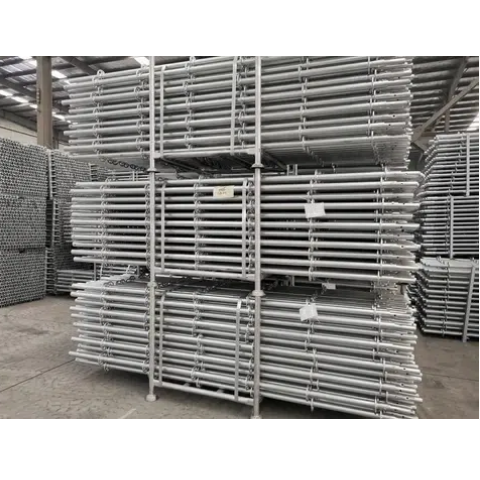English 

T: +86-18842539857
E: anniescaffolding@163.com
E: anniescaffolding@163.com
Room No.203, Building No.5, Huijin Plaza, West Fifth Road No.35, Tianjin Airport Economic Zone, Tianjin, China

Views: 0 Author: Site Editor Publish Time: 2025-09-30 Origin: Site









When projects involve curves, irregular facades, or heavy industrial layouts, scaffold planning becomes a precise engineering exercise. Ringlock Scaffolding offers the adaptability needed to handle these challenges, but successful outcomes depend on detailed planning. At Tianjin Easy Scaffolding, we have supplied Ringlock systems for projects worldwide, helping contractors design solutions that balance safety, efficiency, and flexibility. This article explores the practical steps for planning Ringlock Scaffolding around complex structures.
At the heart of Ringlock Scaffolding is the rosette, a circular node with eight connection points. Four are placed at right angles for standard ledgers, while the other four are elongated slots designed for angled connections. This clever geometry is what allows the system to adapt to irregular building shapes without compromising structural integrity.
For projects with balconies, rounded facades, or diagonal beams, the rosette connection provides an advantage over traditional fixed systems. Workers can position ledgers at non-standard angles, enabling the scaffold to wrap tightly around a structure. This reduces the need for excessive fittings or custom parts and ensures that the scaffold remains safe and stable even when geometry gets complicated.
In practice, engineers rely on this flexibility when working on bridges with sloping spans or industrial plants with pipes and tanks. The rosette becomes the central planning tool: once its placement is set, ledgers and transoms can extend in multiple directions to follow the building’s shape accurately. The result is a scaffold that feels purpose-built for every curve and corner, rather than a rigid frame forced to fit.
Planning Ringlock Scaffolding is not just about geometry; it also requires careful structural analysis. Every scaffold must safely transfer loads from working platforms down to the ground. For complex projects, understanding load paths is essential.
Heavy-load bays, such as those supporting formwork or construction equipment, demand special attention. Engineers often specify truss ledgers for areas that need to span longer distances without intermediate support. These trusses distribute weight across multiple standards and prevent localized overloading. In contrast, lighter access bays may use standard ledgers and transoms, keeping the system economical without reducing safety.
Another consideration is the sequencing of standards. Where a scaffold wraps around a curved facade, additional verticals may be required to prevent eccentric loading. Careful planning ensures that each bay contributes evenly to the structure’s stability, avoiding weak points.
Modern planning also uses digital modeling to simulate load paths before construction begins. Software tools can map how weight will shift across ledgers and trusses, allowing adjustments before materials arrive on site. This integration of engineering knowledge with advanced design tools ensures Ringlock Scaffolding is not only versatile but also precisely calculated to handle real-world demands.

Each type of complex project brings unique challenges, and Ringlock Scaffolding is designed to address them with precision.
For bridges, scaffolds must often be erected over water or traffic, requiring shoring towers that can support heavy loads while allowing free passage beneath. Tie-ins are critical to stabilize the scaffold against lateral forces, and engineers may specify reinforced bays to handle vibration or wind loads.
On building facades, particularly those with glass or decorative cladding, access must be secure without damaging the surface. Scaffold planning focuses on fixing points that minimize contact with delicate materials. Ringlock’s modular connections allow platforms to step in and out around obstacles, keeping workers close to the facade without leaving gaps.
In industrial plants, scaffolding often surrounds tanks, machinery, or pipework. The rosette’s angled slots allow ledgers to snake around these obstacles, creating safe access paths for maintenance crews. In many cases, scaffold planning combines access functions with shoring or support, demonstrating the system’s ability to serve multiple roles in one build.
These examples highlight why generic scaffolding systems struggle in special applications, while Ringlock excels. The combination of modular strength and angular flexibility allows planners to treat every project as unique, without sacrificing speed or safety.
Even the best plan can fall short if the wrong components are chosen. Material selection plays a decisive role in the success of complex scaffolding projects.
For heavy-duty requirements, high-strength steel standards and ledgers are recommended, ensuring that the system can withstand higher point loads. When spanning longer distances, truss ledgers and reinforced transoms distribute loads more evenly. Adjustable base jacks provide the flexibility needed to level scaffolds on sloped or uneven ground—common in bridge and industrial projects.
Couplers and spigots must also be considered. While Ringlock systems minimize the number of additional fittings, strategic use of couplers can enhance stability in irregular builds. Scaffold planners must match ledger lengths carefully to the site’s dimensions, avoiding unnecessary overhangs or gaps.
By selecting the correct combination of steel grade, ledger sizes, and accessories, contractors can build scaffolds that are not only safe but also efficient to erect and dismantle. At Tianjin Easy Scaffolding, every Ringlock Scaffolding component is produced under strict quality control to ensure durability and compatibility across a wide range of configurations. That consistency allows planners to trust that each component will perform exactly as expected, even in demanding builds.
The complexity of a scaffold does not end with its design. Logistics and erection planning are equally important. A well-planned scaffold project anticipates how materials will move to site, how assemblies will be staged, and how dismantling will proceed when work is complete.
For complex configurations, pre-assembly of certain units can save significant time on site. Packing lists must be detailed, ensuring that the right lengths of ledgers, number of rosettes, and accessories are delivered in the correct sequence. Proper labeling of components is particularly valuable on large export projects, where scaffolds may need to be erected by crews unfamiliar with the site’s specific design.
Safety also depends on sequence. By planning erection in phases, engineers ensure that partial structures remain stable at every stage. Dismantling follows similar rules, avoiding the removal of critical supports too early. With Ringlock Scaffolding’s modular design, crews can follow a logical order that maintains safety while optimizing labor time.
Another benefit of detailed logistics planning is reduced waste and downtime. When components arrive organized and pre-checked, crews can focus on safe erection rather than searching for missing pieces. This approach improves both project efficiency and overall worker safety.
Planning Ringlock Scaffolding for complex structures requires a deep understanding of geometry, load distribution, material selection, and logistics. With the rosette connection at its core, the system provides unmatched flexibility to wrap around curved facades, support heavy loads, or access industrial equipment safely. At Tianjin Easy Scaffolding, we deliver Ringlock Scaffolding solutions that meet international standards and adapt to unique project requirements worldwide. If your next project demands precision and safety in scaffold planning, contact us today to discuss a tailored solution.